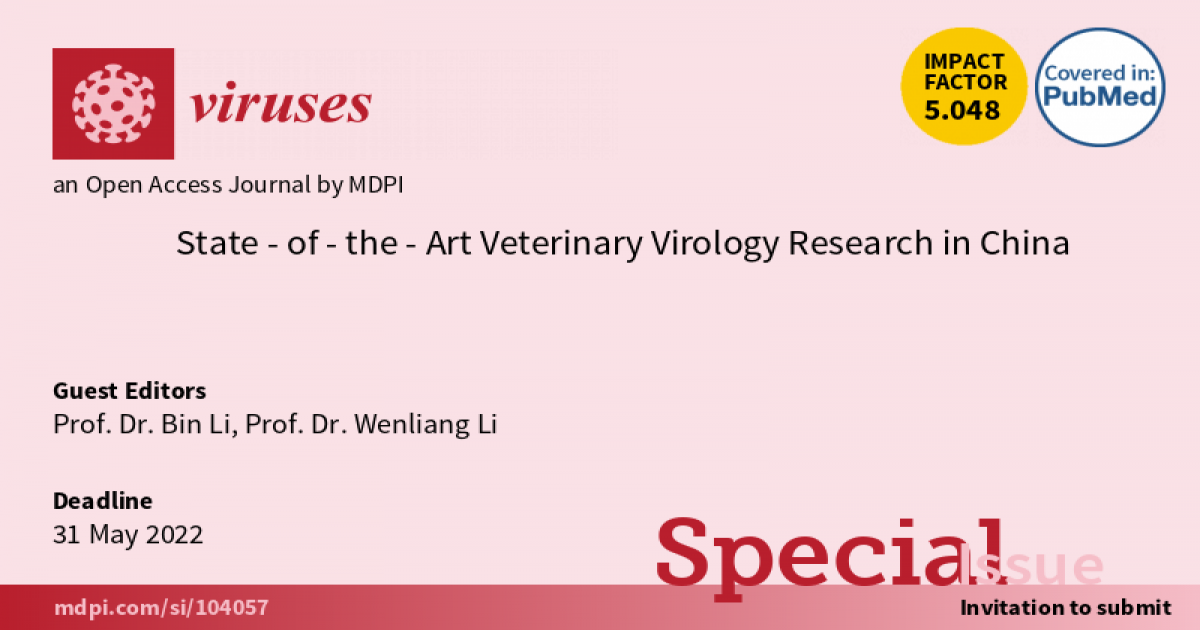- 3.5Impact Factor
- 7.7CiteScore
- 19 daysTime to First Decision
State-of-the-Art Veterinary Virology Research in China
This special issue belongs to the section “General Virology“.
Special Issue Information
Dear Colleagues,
China is a major country regarding the practice of the animal husbandry, which occupies an important position in the national economy. Over recent decades, intensive animal production (especially pig, poultry, cattle, etc.) has been developed rapidly. Infectious disease, especially viral diseases, have posed adverse impacts on the healthy development of animal husbandry. Chinese veterinarians and researchers consistently struggle with several emerging and re-emerging viruses which are important to animal health. Fortunately, tremendous strides have been made by Chinese virologists in different areas of animal viral diseases, promoting the prevention and control of such diseases.
In this Special Issue, we will focus on state-of-the-art veterinary virology research in China. Animal species to be discussed include, but are not limited to pigs, poultry, cattle, small ruminants, pets and economic animals. We invite you to submit your most recent research findings and/or insights into this topic. We welcome reviews and original research articles focused on the following topics:
- Emerging and re-emerging viruses;
- Epidemiology;
- Pathogenesis;
- Diagnostics;
- Virus evolution;
- Virus–host interactions;
- Prophylaxis and prevention;
- Vaccines;
- Antivirals;
- Viral immunology;
- Virus structure.
Prof. Dr. Bin Li
Prof. Dr. Wenliang Li
Guest Editors
Manuscript Submission Information
Manuscripts should be submitted online at www.mdpi.com by registering and logging in to this website. Once you are registered, click here to go to the submission form. Manuscripts can be submitted until the deadline. All submissions that pass pre-check are peer-reviewed. Accepted papers will be published continuously in the journal (as soon as accepted) and will be listed together on the special issue website. Research articles, review articles as well as short communications are invited. For planned papers, a title and short abstract (about 250 words) can be sent to the Editorial Office for assessment.
Submitted manuscripts should not have been published previously, nor be under consideration for publication elsewhere (except conference proceedings papers). All manuscripts are thoroughly refereed through a single-blind peer-review process. A guide for authors and other relevant information for submission of manuscripts is available on the Instructions for Authors page. Viruses is an international peer-reviewed open access monthly journal published by MDPI.
Please visit the Instructions for Authors page before submitting a manuscript. The Article Processing Charge (APC) for publication in this open access journal is 2600 CHF (Swiss Francs). Submitted papers should be well formatted and use good English. Authors may use MDPI's English editing service prior to publication or during author revisions.
Keywords
- Emerging and re-emerging viruses
- Epidemiology
- Pathogenesis
- Diagnostics
- Virus evolution
- Virus–host interactions
- Prophylaxis and prevention
- Vaccines
- Antivirals
- Viral immunology
- Virus structure

Benefits of Publishing in a Special Issue
- Ease of navigation: Grouping papers by topic helps scholars navigate broad scope journals more efficiently.
- Greater discoverability: Special Issues support the reach and impact of scientific research. Articles in Special Issues are more discoverable and cited more frequently.
- Expansion of research network: Special Issues facilitate connections among authors, fostering scientific collaborations.
- External promotion: Articles in Special Issues are often promoted through the journal's social media, increasing their visibility.
- e-Book format: Special Issues with more than 10 articles can be published as dedicated e-books, ensuring wide and rapid dissemination.

